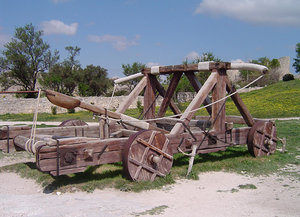Catapult
|
|
Catapults are siege engines using an arm to hurl a projectile a great distance. Any machine that hurls an object can be considered a catapult, but the term is generally understood to mean medieval siege weapons.
The name is derived from the Greek κατα (against) and παλλειγ(to hurl (a missile)). Originally, "catapult" referred to a dart-thrower, while "ballista" referred to a stone-thrower, but over the years, the two terms have swapped meaning.
Catapults were usually assembled at the site of a siege, and an army carried few or no pieces of it with them because wood was easily available on site.
| Contents |
Types
Catapults can be classified according to the physical concept used to store and release the energy required to propel the projectile.
The first catapults were tensional catapults, developed from the Roman ballista. A member under tension propels the throwing arm, very much like a giant crossbow. A small simple version is used as a toy.
Subsequently, torsional catapults were developed, such as the mangonel and the onager. Mangonels have an arm with a bucket, cup, or most often a sling to hold the projectile at one end. The bottom end of the throwing arm is inserted in rope or fibers that are twisted, providing the force to propel the arm.
The most sophisticated catapult is a trebuchet, which uses gravity rather than tension or torsion to propel the throwing arm. A falling counterweight pulls down the bottom end of the arm and the projectile is thrown from a bucket attached to a rope hanging from the top end of the arm, essentially like a sling attached to a giant see-saw. The counterweight is heavier than the projectile.
History
In Europe, the first catapults appeared in later Greek times (400 BC-300 BC), early adopters being Dionysius of Syracuse and Onomarchus of Phocis. Alexander the Great introduced the idea of using them to provide cover on the battlefield in addition to using them during sieges.
Catapults were more fully developed in Roman and Medieval times, with the trebuchet being introduced a relatively short time before the advent of gunpowder, which made the catapult obsolete.
During medieval times, catapults and related siege machines were the first weapons used for biological warfare. The carcasses of diseased animals and those who had perished from the Black Death or other diseases were loaded up and then thrown over the castle's walls to infect those barricaded inside.
Most real catapults used slings. The cup design, as seen in many movies, is highly inefficient. This can be demonstrated by taking a ball and cupping your hand, placing your elbow on a table, and throwing the ball as far as you can. Then attach the same ball to a string and throw again--you'll find that you can throw it much further. This was known as far back as the Roman empire, and continued throughout the Middle Ages. Historical documents showing cups were likely specifically altered illustrations in order to fool the enemy should the documents fall into their hands.
See also
References
Catapult. The Compact Edition of the Oxford English Dictionary (1971)

